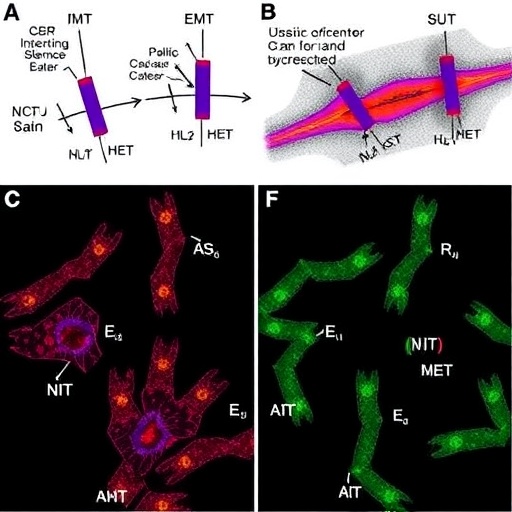In a groundbreaking new study published in BMC Cancer, researchers have unveiled a pivotal role for the gene ADAMTS2 in driving epithelial–mesenchymal transition (EMT) and inflammatory processes within high-grade serous ovarian cancer (HGSOC). This research combines comprehensive bioinformatic analyses with robust experimental validation, shedding light on molecular mechanisms that until now remained dense mysteries in ovarian cancer progression and metastasis.
HGSOC is notorious for its aggressive behavior and poor prognosis, in part due to its propensity for early invasion and metastasis. Central to these processes is EMT, a finely tuned biological program where epithelial cells acquire mesenchymal traits, enhancing motility and invasiveness. While EMT’s contribution to tumor spread is well established, pinpointing reliable genetic biomarkers to predict and target EMT in HGSOC has been a persistent challenge.
Harnessing transcriptomic data from 366 HGSOC patients sourced from The Cancer Genome Atlas (TCGA), the researchers utilized the Gene Set Variation Analysis (GSVA) algorithm alongside the ESTIMATE method to elucidate the landscape of EMT hallmark expression and its interplay with the tumor microenvironment. These analyses revealed a significant correlation between EMT scores and disease progression, immune contexture, and patient survival, confirming EMT’s central role in ovarian cancer pathobiology.
To distill key regulatory players within the EMT network, the team employed sophisticated machine learning algorithms, which collectively spotlighted seven critical EMT-related genes: MMP2, ADAMTS2, FN1, THBS2, C3ORF80, FAP, and POSTN. Among these, ADAMTS2—encoding a metalloproteinase involved in extracellular matrix remodeling—emerged as a novel and potent mediator of the EMT and inflammatory cascade in HGSOC.
Further validation was performed on tissue samples, where quantitative PCR, western blotting, and immunohistochemical staining corroborated the elevated expression of ADAMTS2 in ovarian cancer tissues compared to normal ovarian epithelium. This marked upregulation suggested a direct association of ADAMTS2 with malignant transformation and tumor aggressiveness in serous ovarian cancer.
Crucially, functional in vitro experiments elucidated the impact of manipulating ADAMTS2 levels on HGSOC cell behavior. Knockdown of ADAMTS2 attenuated key malignant phenotypes, including cell proliferation, migration, and invasion. Conversely, overexpression of ADAMTS2 amplified these aggressive cellular behaviors, underscoring its role as a driver of cancer progression.
The study also delved deep into the interplay between ADAMTS2 and inflammatory mediators. Silencing ADAMTS2 correlated with decreased expression of pro-inflammatory cytokines such as tumor necrosis factor-alpha (TNF-α) and interleukin-1 beta (IL-1β), both known contributors to tumor-promoting inflammation. This suggests that ADAMTS2 modulates the tumor microenvironment by orchestrating crosstalk between EMT programs and inflammatory pathways.
Further molecular analyses demonstrated that ADAMTS2 influenced the expression of core EMT markers: it suppressed epithelial marker E-cadherin and upregulated mesenchymal markers including N-cadherin, SLUG, and TWIST1. These transcription factors are classic drivers of EMT, reinforcing the master regulatory position of ADAMTS2 in modulating cellular plasticity.
This study not only enriches the understanding of the molecular underpinnings of EMT in HGSOC but also introduces a novel classifier model integrating EMT signatures to predict immune microenvironment status. Such predictive tools are invaluable for stratifying patients, optimizing treatment regimens, and tailoring immunotherapeutic interventions.
The implications of these findings are profound and multifaceted. By defining ADAMTS2 as a novel regulator connecting EMT and inflammation, therapeutic strategies targeting this metalloproteinase could be developed to impede tumor progression and potentially sensitize tumors to emerging immunotherapies.
Notably, the integration of bioinformatics, machine learning, and molecular biology in this study exemplifies the modern confluence of computational and experimental oncology. It demonstrates how high-dimensional genomic data, when intelligently mined and experimentally vetted, can yield translationally relevant biomarkers and targets.
Given the dismal survival rates associated with late-stage ovarian cancer, the identification of actionable targets like ADAMTS2 ushers in new hope. Customized inhibitors or RNA interference approaches against ADAMTS2 might suppress EMT-driven dissemination, a major driver of therapeutic resistance and relapse.
Furthermore, the study highlights the critical role of the tumor microenvironment in shaping cancer progression. By linking ADAMTS2 expression to the release of inflammatory cytokines, it paves the way for combined therapeutic regimes that disrupt both the cellular and stromal components fueling tumor aggressiveness.
Looking forward, in vivo studies and clinical trials will be vital to evaluate the efficacy and safety of ADAMTS2-targeted therapies. The heterogeneity of HGSOC calls for carefully designed biomarker-driven stratification to maximize patient benefit.
In conclusion, this pioneering research compellingly positions ADAMTS2 at the nexus of EMT and inflammation in high-grade serous ovarian cancer. It not only advances mechanistic insights but also charts a promising path toward innovative, translational cancer interventions aimed at prolonging survival and improving quality of life for patients afflicted by this devastating disease.
Subject of Research:
The role of ADAMTS2 in mediating epithelial–mesenchymal transition and inflammation in high-grade serous ovarian cancer, including its impact on tumor progression, immune microenvironment, and potential as a therapeutic target.
Article Title:
ADAMTS2 mediates epithelial‒mesenchymal transition and inflammation in high-grade serous ovarian cancer: a study based on bioinformatic analyses and experiments.
Article References:
Tian, Y., Li, J., Dong, R. et al. ADAMTS2 mediates epithelial‒mesenchymal transition and inflammation in high-grade serous ovarian cancer: a study based on bioinformatic analyses and experiments. BMC Cancer 25, 1376 (2025). https://doi.org/10.1186/s12885-025-14649-0
Image Credits: Scienmag.com
DOI: https://doi.org/10.1186/s12885-025-14649-0
Tags: ADAMTS2 gene role in ovarian cancerbioinformatic analysis in cancer researchbiomarkers for EMT in ovarian cancercancer prognosis and patient survivalEMT and immune contextureepithelial-mesenchymal transition in HGSOChigh-grade serous ovarian cancer researchinflammation in ovarian cancermetastasis in ovarian cancermolecular mechanisms of cancer progressiontranscriptomic analysis of ovarian cancertumor microenvironment in HGSOC





